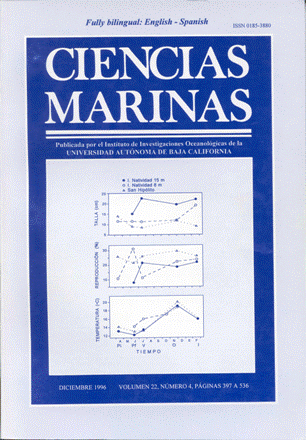Effect of turbidity on primary productivity at two stations in the area of the Colorado River Delta
Main Article Content
Abstract
Most coastal lagoons that present high tide intervals and high turbulent kinetic energy have high turbidity and, therefore, light is a limiting factor for primary productivity. The Colorado River Delta has been reported with high turbidity values. Our purpose is to estimate the effect of turbidity on primary productivity. We took water samples from two locations within the Colorado River Delta (one turbid and another less turbid). We carried out daily experiments on primary productivity with the 14C technique during spring and neap tides, from 15 to 22 May, I991. We used artificial light incubators with lamps of cool white constant light with 66.33 uE m–2 s–1 of irradiance and another with a stroboscopic lamp with white xenon light with 66.17 uE m–2 s–1 of irradiance. In general, in the samples from the high turbid location we found a higher concentration of chlorophyll a and a higher concentration of chlorophyll a per cell. In the incubations with the stroboscopic lamp, the samples from the turbid station showed higher assimilation rates and assimilation rates per cell than the samples from the clear station. Meanwhile, for the samples from the clear station, the assimilation rates and assimilation rates per cell were higher in the incubations with constant light.
Downloads
Article Details
This is an open access article distributed under a Creative Commons Attribution 4.0 License, which allows you to share and adapt the work, as long as you give appropriate credit to the original author(s) and the source, provide a link to the Creative Commons license, and indicate if changes were made. Figures, tables and other elements in the article are included in the article’s CC BY 4.0 license, unless otherwise indicated. The journal title is protected by copyrights and not subject to this license. Full license deed can be viewed here.

